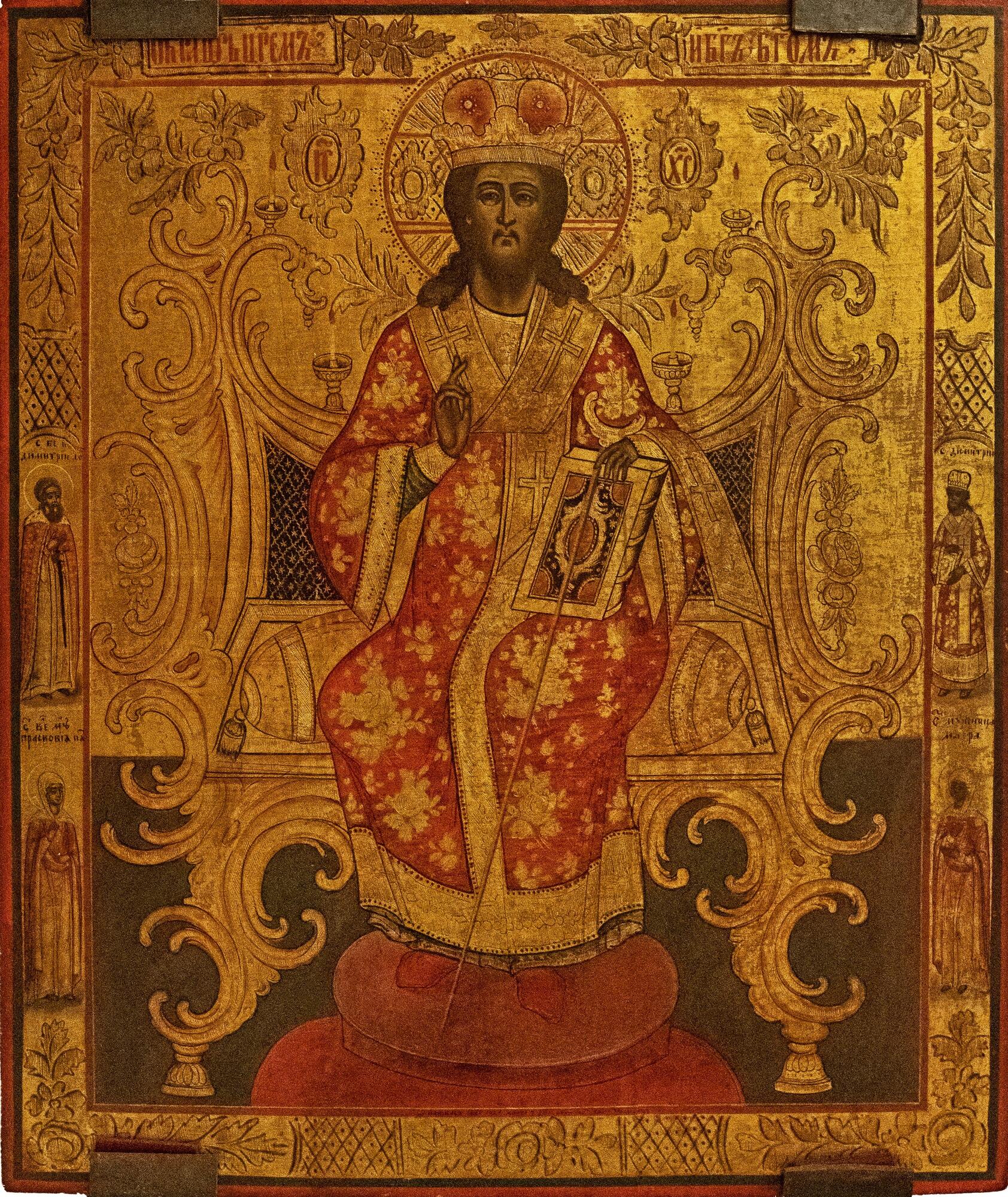Grigory Chulimov painted the icon ‘The King of Kings’ in 1829. Born in 1790, he lived and worked in the village of Starocherkasskaya and was listed as a merchant of the 3rd guild. Together with his son Alexander, he painted and renewed icons — including the ones in the Starocherkassk Army Cathedral of Christ’s Resurrection.
“Christ the King of Kings” is an iconographic image of Jesus Christ, in which He is represented as the King and the Great Bishop. In these images, the Savior is seated on the throne. “The King of Kings” is a variation — a derivation — of “The Lord on the Throne”.
“The King of Kings” from the museum’s exhibition, painted by Grigory Chulimov, is a full-length image of Jesus Christ in the special recess on the icon board called the ‘ark’. Christ holds his right hand in a blessing gesture, and in his left hand, he has a book. This makes the image look closer related to the iconography of Christ the Almighty. Jesus is depicted against a gold background with floral ornaments; he is dressed in royal attire — a dalmatic and a loros.
The dalmatic is a type of imperial Byzantine costume worn by the emperors. It was made from expensive red fabric and decorated with gold and gemstones. In the icons, the red color symbolizes not only the power of the emperor, but also martyrdom — since red is the color of blood. When he was mocked, Christ was wearing the same kind of a purple robe, which looked like royal attire. The loros is a long, wide strip of cloth, which was decorated with pearls and gemstones.
On top of the royal garment, there is another wide, long band of cloth decorated with crosses — an omophorion. Bishops wear this type of vestment at any divine service. On his head the Savior wears a crown in the form of a kalimavkion.
There are some inscriptions around the image of Christ — ‘The King of Kings’, ‘The Righteous Judge’, ‘The Terrible Judge’, ‘The King of Kings and the Lord of Lords’.
In ‘The King of Kings’ iconographic type, Jesus Christ can be painted both as a separate image and as part of the Deesis composition ‘At your right hand is the royal bride’. In the Deesis, the icon painters depict Christ flanked by the Virgin Mary and St. John the Baptist. The iconography of ‘Christ the King of Kings’ is also close to the iconography of the Savior ‘The Great Bishop’. The figure of the Lord is featured either alone, or, as in the icon from the Rostov museum, with the saints — with ‘those in the presence of God’.
In the icon ‘The King of Kings’, the image of Christ is a symbol of the connection between the Old and the New Testament Church, the highest justice and the superiority of the Kingdom of Heaven over all the earthly affairs.
“Christ the King of Kings” is an iconographic image of Jesus Christ, in which He is represented as the King and the Great Bishop. In these images, the Savior is seated on the throne. “The King of Kings” is a variation — a derivation — of “The Lord on the Throne”.
“The King of Kings” from the museum’s exhibition, painted by Grigory Chulimov, is a full-length image of Jesus Christ in the special recess on the icon board called the ‘ark’. Christ holds his right hand in a blessing gesture, and in his left hand, he has a book. This makes the image look closer related to the iconography of Christ the Almighty. Jesus is depicted against a gold background with floral ornaments; he is dressed in royal attire — a dalmatic and a loros.
The dalmatic is a type of imperial Byzantine costume worn by the emperors. It was made from expensive red fabric and decorated with gold and gemstones. In the icons, the red color symbolizes not only the power of the emperor, but also martyrdom — since red is the color of blood. When he was mocked, Christ was wearing the same kind of a purple robe, which looked like royal attire. The loros is a long, wide strip of cloth, which was decorated with pearls and gemstones.
On top of the royal garment, there is another wide, long band of cloth decorated with crosses — an omophorion. Bishops wear this type of vestment at any divine service. On his head the Savior wears a crown in the form of a kalimavkion.
There are some inscriptions around the image of Christ — ‘The King of Kings’, ‘The Righteous Judge’, ‘The Terrible Judge’, ‘The King of Kings and the Lord of Lords’.
In ‘The King of Kings’ iconographic type, Jesus Christ can be painted both as a separate image and as part of the Deesis composition ‘At your right hand is the royal bride’. In the Deesis, the icon painters depict Christ flanked by the Virgin Mary and St. John the Baptist. The iconography of ‘Christ the King of Kings’ is also close to the iconography of the Savior ‘The Great Bishop’. The figure of the Lord is featured either alone, or, as in the icon from the Rostov museum, with the saints — with ‘those in the presence of God’.
In the icon ‘The King of Kings’, the image of Christ is a symbol of the connection between the Old and the New Testament Church, the highest justice and the superiority of the Kingdom of Heaven over all the earthly affairs.



